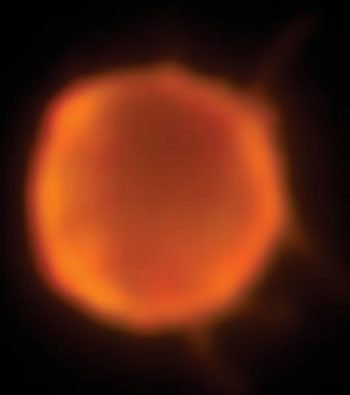Leukemia Cells Are Killed in Culture by Immune Cells Grown from the Same Patient
By LabMedica International staff writers
Posted on 02 Sep 2014
Immune system natural killer (NK) cells were isolated from leukemia patients, expanded in culture, and then shown in an in vitro system to attack and destroy cancer cells from the original cell donors.Posted on 02 Sep 2014
Acute lymphoblastic leukemia (ALL) is characterized by an excessive amount of white blood cell precursors (B-cell lymphoblasts) in the blood and bone marrow. B-cell lineage ALL (pre-B ALL) accounts for 80 to 85% of childhood ALL.

Image: A leukemia cell coated with antibody is marked for destruction by activated natural killer cells (Photo courtesy of the University of Southern California).
Investigators at the University of Southern California (Los Angeles, USA) used flow cytometry to determine that ALL patient samples at diagnosis, post-induction, and relapse contained detectable numbers of CD56+ cells. They were able to selectively expand these CD56+ immune effector (NK) cells from bone marrow and peripheral blood samples at diagnosis and at various stages of treatment by co-culture with artificial antigen-presenting K562 clone 9.mbIL-21 cells. They combined these expanded immune effector cells with a monoclonal antibody targeted to a specific receptor (BAFF-R) on the leukemia cells.
BAFF-R is encoded in humans by the TNFRSF13C (tumor necrosis factor receptor superfamily member 13C) gene. BAFF enhances B-cell survival in vitro and is a regulator of the peripheral B-cell population. Overexpression of BAFF in mice results in mature B-cell hyperplasia and symptoms of systemic lupus erythematosus (SLE). Also, some SLE patients have increased levels of BAFF in their serum. Therefore, it has been proposed that abnormally high levels of BAFF may contribute to the pathogenesis of autoimmune diseases by enhancing the survival of autoreactive B cells. The protein encoded by the TNFRSF13C gene is a receptor for BAFF and is a type III transmembrane protein containing a single extracellular cysteine-rich domain.
It is thought that BAFF-R is the principal receptor required for BAFF-mediated mature B-cell survival. Since BAFF-R is expressed on precursor pre-B ALL cells but not on their pre-B normal counterparts, selective killing of ALL cells is possible by targeting this receptor.
Results revealed that matched CD56+ effector cells killed autologous ALL cells grown out from leukemia samples of the same patient, through both spontaneous as well as antibody-dependent cellular cytotoxicity. Since autologous cell therapy avoids the potential development of graft-versus-host disease, these results indicate that expanded CD56+ cells could be applied for treatment of pre-B-ALL without transplantation, or for purging of bone marrow in the setting of autologous bone marrow transplants.
“In this study, we used NK cells and ALL cells from the same pediatric patients. We found that autologous natural killer cells will destroy the patient’s leukemia cells,” said senior author Dr. Nora Heisterkamp, professor of research, pediatrics, and pathology at the University of Southern California.
Related Links:
University of Southern California













